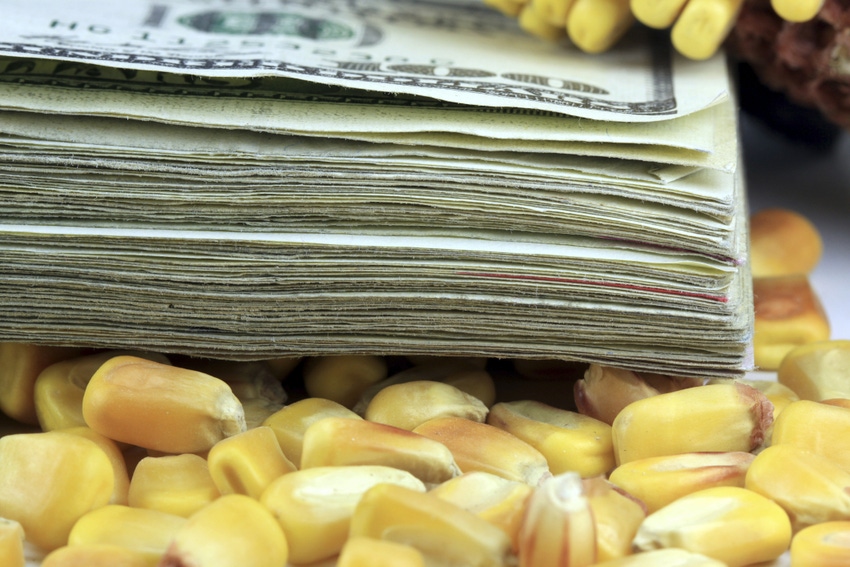Bankers say ag sector to face continued headwinds
Farm income down, while farmland values have remained supported for now.

As the agriculture sector continues to face lower commodity prices and trade uncertainty, agricultural bankers are reporting strained balance sheets for their farmer customers. Meanwhile, farmland values have remained supported but could face downward pressure if prices remain low.
In their latest "Ag Credit Survey" report, Federal Reserve Bank of Kansas City, Mo., economist Cortney Cowley and assistant economist Ty Kreitman with the 10th District, said, “Lower income continued to strain working capital, and the share of bankers with operators planning to sell mid- to long-term assets increased from a year ago.”
Throughout the 10th District, more than half of bankers reported lower farm income compared to a year ago, while less than 5% reported higher income. The drop was sharpest in states with higher concentrations of corn and soybeans. For example, more than 80% of bankers in Missouri and 60% of bankers in Nebraska reported lower income, Cowley and Kreitman wrote.
In the Seventh District, the Federal Reserve Bank of Chicago, Ill., reported that in Iowa, Michigan and parts of Illinois, Indiana and Wisconsin, only 5% of survey respondents anticipated crop net cash earnings to rise over the next three to six months relative to a year ago, while 82% anticipated these earnings to fall.
“According to the responding bankers, hog, cattle and dairy farmers were yet again expected to encounter diminished net cash earnings over the fall and winter relative to a year ago. Just 3% of the survey respondents predicted higher net earnings for hog and cattle operations over the next three to six months relative to a year earlier, while 65% predicted lower net earnings. Similarly, 1% of survey respondents anticipated higher net earnings for dairy operations this fall and winter compared with a year ago, while 66% anticipated lower net earnings,” David Oppedahl, senior business economist at the Chicago Federal Reserve Bank, said.
An Iowa respondent emphasized the “concern from row crop farmers regarding interest rate increases next year and low commodity prices.” This concern was echoed by livestock operators. “So, there was a decidedly downcast outlook for agriculture based on the latest survey responses,” Oppedahl added.
The majority of agricultural bankers continue to report declines in farm income relative to a year earlier, according to the St. Louis, Mo., Federal Reserve Bank's agricultural survey. Overall, bankers were slightly less optimistic when asked about the prospects for farm income in the fourth quarter of 2018.
Farmland values mixed
Farmland values across the Midwest were mixed, according to the latest reports from Federal Reserve Banks in the region. Farmland values remained stable and continued to support agricultural credit conditions, but increasing stress in the sector could put downward pressure on farm real estate moving forward.
The Kansas City Federal Reserve Bank noted that, despite prolonged weaknesses in the farm economy and recent declines in farm income, cash rents have decreased only modestly and have appeared to stabilize in recent quarters. “In fact, cash rents for ranchland increased almost 5% from a year ago. In addition, cash rents for irrigated farmland fell at the slowest pace since 2013, and the downward trend in non-irrigated farmland rents remained modest,” Cowley and Kreitman wrote.
Alongside lower farm income and declining liquidity, a majority of bankers expected farmland values to decrease in the next quarter, but at a slower pace than in previous years. Bankers in Nebraska, Kansas and western Missouri were also most pessimistic about the outlook for farmland values. “Despite predicted declines, further deterioration of farm finances and rising interest rates, non-irrigated farmland values across the district decreased only 2% from a year ago,” Cowley and Kreitman said.
In the latest "Ag Letter," Oppedahl wrote that Seventh District farmland values saw a year-over-year increase of 1% for the third quarter of 2018. However, after being adjusted for inflation, district farmland values were down 1% for the quarter relative to the prior year.
“The latest results were in line with recent trends: While nominal farmland values had remained fairly stable during the past few years, real farmland values had been eroding since the third quarter of 2014,” Oppedahl said. “Agricultural land values would have experienced more downward pressure in the absence of exceptional crop yields.”
Oppedahl said nearly two-thirds of survey respondents predict farmland values to be stable in the fourth quarter of 2018, while 32% expect farmland values to decrease in the October-to-December 2018 period, and just 2% expect farmland values to increase.
“Also, more respondents anticipated weaker rather than stronger demand by farmers and non-farm investors to acquire farmland this fall and winter compared with a year earlier,” he wrote. “Still, on the whole, respondents expected an uptick in transfers of available properties for sale. Twenty-six percent of the responding bankers forecasted an increase in the volume of farmland transfers relative to the fall and winter of a year ago, and 21% forecasted a decrease.”
In the St. Louis region, quality farmland values rose 2.5% in the third quarter, while ranchland or pastureland values increased 1.5%. Cash rents for quality farmland rose 2% in the third quarter, while cash rents for ranchland or pastureland rose 0.8%. “Bankers are split on whether cash rents for ranchland and pastureland will decrease or increase over the next three months,” the survey noted.
About the Author(s)
You May Also Like





